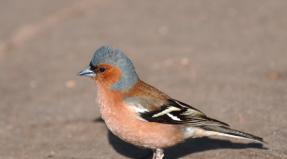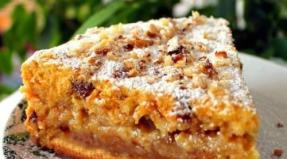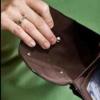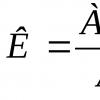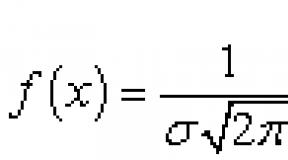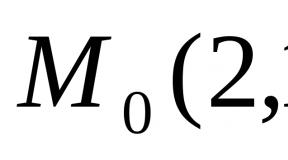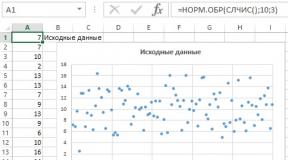L pasteur discoveries in biology. Louis Pasteur and his discoveries: interesting facts and videos
Pasteur, Louis (1822-1895), French microbiologist and chemist. Born December 27, 1822 in Dole. He graduated from the Higher Normal School in Paris (1847), defended his doctoral dissertation (1848). He taught natural sciences in Dijon (1847–1848), was a professor at Strasbourg (1849–1854) and Lille (since 1854) universities. In 1857 he became dean of the faculty of natural sciences at the Higher Normal School, from 1867 - professor of chemistry at the University of Paris. In 1888 he founded and headed the Research Microbiological Institute (later the Pasteur Institute).
Pasteur made his first discovery in his student years, discovering the optical asymmetry of molecules. Separating two crystalline forms of tartaric acid from each other, he showed that they differ in their optical activity (right- and left-handed forms). These studies formed the basis of a new scientific direction - stereochemistry. Later, Pasteur found that optical isomerism is characteristic of many organic compounds, while natural products, unlike synthetic ones, are represented by only one of two isomeric forms.
Since 1857, Pasteur began to study the processes of fermentation. As a result of numerous experiments, he proved that fermentation is a biological process caused by the activity of microorganisms. Developing these ideas further, he argued that each type of fermentation (lactic acid, alcohol, acetic) is caused by specific microorganisms (“embryos”). Pasteur outlined his theory in an article on fermentation called lactic (Sur la fermentation appelée lactique, 1857). In 1861 he discovered microorganisms that cause butyric fermentation - anaerobic bacteria that live and develop in the absence of free oxygen. The discovery of anaerobiosis led Pasteur to the idea that for organisms that live in an oxygen-deprived environment, fermentation replaces respiration. In 1860–1861, Pasteur proposed a method of preserving foodstuffs through heat treatment (later called pasteurization).
In 1865, Pasteur began to study the nature of the silkworm disease and, as a result of many years of research, developed methods for combating this infectious disease (1880). Studied other contagious diseases of animals and humans (anthrax, rabies, night blindness, swine rubella, etc.). Proposed a method of inoculation against these and others infectious diseases using attenuated cultures of the corresponding pathogens. He proposed to call weakened cultures vaccines, and the procedure for their use - vaccination. In 1880 Pasteur established the viral nature of rabies.
Monument to Louis Pasteur. Photo: couscouschocolat
Pasteur made a number of outstanding discoveries. In a short period from 1857 to 1885, he proved that fermentation (lactic, alcoholic, acetic) is not a chemical process, but is caused by microorganisms; refuted the theory of spontaneous generation; discovered the phenomenon of anaerobiosis, i.e. the possibility of life of microorganisms in the absence of oxygen; laid the foundations for disinfection, asepsis and antisepsis; discovered a way to protect against infectious diseases through vaccination.
Many of L. Pasteur's discoveries have brought enormous practical benefits to humanity. By heating (pasteurization) diseases of beer and wine, lactic acid products caused by microorganisms were defeated; to prevent purulent complications of wounds, an antiseptic was introduced; Based on the principles of L. Pasteur, many vaccines have been developed to combat infectious diseases.
However, the significance of the works of L. Pasteur goes far beyond just these practical achievements. L. Pasteur brought microbiology and immunology to fundamentally new positions, showed the role of microorganisms in people's lives, economy, industry, infectious pathology, laid down the principles by which microbiology and immunology are developing in our time.
L. Pasteur was, moreover, an outstanding teacher and organizer of science.
L. Pasteur's work on vaccination opened a new stage in the development of microbiology, rightfully called immunological.
The principle of attenuation (weakening) of microorganisms using passages through a susceptible animal or by keeping microorganisms under adverse conditions (temperature, drying) allowed L. Pasteur to obtain vaccines against rabies, anthrax, chicken cholera; this principle is still used in the preparation of vaccines. Consequently, L. Pasteur is the founder of scientific immunology, although even before him the method of preventing smallpox by infecting people with cowpox, developed by the English physician E. Jenner, was known. However, this method has not been extended to the prevention of other diseases.
Robert Koh. The physiological period in the development of microbiology is also associated with the name of the German scientist Robert Koch, who developed methods for obtaining pure cultures of bacteria, staining bacteria during microscopy, and microphotography. Also known is the Koch triad formulated by R. Koch, which is still used in establishing the causative agent of the disease.
The man who was destined to penetrate the secret of the world of pathogenic microbes, to know it in its true light and conquer it, turned out to be Louis Pasteur (1822-1895). Louis Pasteur, a chemist by training, became founder of microbiology and immunology. After studying crystallography and the essence of fermentation processes, he gradually began to study the causes of infectious diseases in animals and humans, starting with silkworm disease, then moved on to avian cholera and, finally, to anthrax.
Louis Pasteur never did not study biology and medicine, but devoted his whole life to their study and development. He was awarded his orders by almost all countries, he is recognized as one of the most prominent scientists of the 19th century.
Louis was born into a simple family and his illiterate father really wanted his son to be smart. He strongly encouraged in the offspring craving for knowledge. And Louis loved to read and draw, and was even listed as a portrait painter of the 19th century. It was impossible to recognize a future scientist in him. Just a diligent and observant student. But at the institute, he became seriously interested in chemistry and physics and began to conduct his developments in this direction, which made him a great scientist. At the age of 45, Pasteur suffered from an apoplexy, and remained disabled for life - the left side was paralyzed. However, he made all his greatest discoveries after a terrible incident. When the scientist died on September 28, 1895, he was 72 years old. An autopsy showed that a huge part of the scientist's brain was affected.
The most important discoveries of Louis Pasteur .
Fermentation he began to study not for the sake of biology, but for economics. He observed the processes that take place when obtaining wine, because winemaking was a major part of the economic life of France. And so he, a chemist and physicist, began to study the fermentation of wine under a microscope. And he established that it is not chemical, but biological process , that is, caused by microorganisms, or rather, the products of their vital activity. He also found out that there are organisms that can survive without oxygen. This element was even fatal to them. Because of their occurrence, a rancid taste appears in wine and beer. A more thorough study of fermentation has made it possible to change the approach not only to the production of products, but also to biological processes.
Pasteurization- the process of heat treatment of products that stops the emergence and reproduction of microorganisms in the product. The phenomenon is named after its inventor Louis Pasteur. In 1865, winemakers turned to the scientist with a request to find the prevention of wine diseases. And after several laboratory tests, he came to the conclusion that for the complete death of harmful microorganisms, it is enough to warm the product to 55-60 degrees for 30 minutes. The same was true with beer.
infectious diseases also became the subject of Pasteur's study not by chance. Silkworms were stricken with an epidemic and were constantly dying out, bringing no income to silk companies. For several years in a row, Louis spent with his family near fields with silkworms, bred his worms and found out that the disease was caused by an infection that was transmitted from one individual to another, as well as to offspring. The scientist devoted his entire future life to the study of infectious diseases in the human body and the search for ways to treat them.
Louis Pasteur was the first to try vaccination on humans and developed the basis for creating artificial immunity confirmed the importance of vaccinations. He paid particular attention to the study rabies, anthrax, puerperal fever and cholera. And on July 6, 1885, a boy was brought to him, who had just been bitten by rabid dog. There was no other way out to save the child, and at the request of the mother, Pasteur vaccinated him. A few days later the boy recovered. After this incident, vaccination gradually entered medical practice.
, Chemist
Louis Pasteur (correctly Pasteur, French Louis Pasteur; December 27, 1822, Dole, Jura department - September 28, 1895, Villeneuve-l'Etang near Paris) - an outstanding French microbiologist and chemist, member of the French Academy (1881).
Pasteur, having shown the microbiological essence of fermentation and many human diseases, became one of the founders of microbiology and immunology. His work in the field of crystal structure and the phenomenon of polarization formed the basis of stereochemistry.
Science should be the most exalted embodiment of the fatherland, for of all peoples the first will always be the one that outstrips others in the field of thought and mental activity.
Pasteur Louis
Pasteur also put an end to the centuries-old dispute about the spontaneous generation of some forms of life at the present time, empirically proving the impossibility of this (see Origin of life on Earth). His name is widely known in non-scientific circles due to the pasteurization technology he created and later named after him.
Louis Pasteur was born in the French Jura in 1822. His father, Jean Pasteur, was a tanner and veteran of the Napoleonic Wars. Louis studied at the College of Arbois, then Besancon. There, the teachers advised him to enter the Higher Normal School in Paris, which he succeeded in 1843. He graduated from it in 1847.
Pasteur showed himself to be a talented artist, his name was listed in the reference books of portrait painters of the 19th century.
Perseverance in scientific research leads to what I like to call the instinct for truth.
Pasteur Louis
Pasteur completed his first scientific work in 1848. Studying physical properties tartaric acid, he discovered that the acid obtained during fermentation has optical activity - the ability to rotate the plane of polarization of light, while the chemically synthesized isomeric tartaric acid does not have this property.
Studying crystals under a microscope, he singled out two types of them, which are, as it were, mirror images of each other. A sample consisting of crystals of one type rotated the plane of polarization clockwise, and the other - counterclockwise. A mixture of the two types 1:1, of course, did not have optical activity.
Pasteur came to the conclusion that crystals are composed of molecules of various structures. Chemical reactions create both types with equal probability, but living organisms use only one of them.
Thus, the chirality of molecules was shown for the first time. As it was discovered later, amino acids are also chiral, and only their L forms are present in living organisms (with rare exceptions). In some ways, Pasteur anticipated this discovery as well.
After this work, Pasteur was appointed associate professor of physics at the Dijon Lyceum, but three months later, in May 1849, he moved to the University of Strasbourg as an associate professor of chemistry.
Pasteur began studying fermentation in 1857. At that time, the theory that this process was of a chemical nature (J. Liebig) dominated, although works about it had already been published. biological character(Sh. Kanyar de Latour, 1837), who did not have recognition. By 1861, Pasteur had shown that the formation of alcohol, glycerol, and succinic acid during fermentation could only occur in the presence of microorganisms, often specific ones.
Louis Pasteur proved that fermentation is a process closely related to the vital activity of yeast fungi, which feed and multiply due to the fermenting liquid. In clarifying this question, Pasteur had to refute Liebig's then dominant view of fermentation as a chemical process.
Particularly convincing were Pasteur's experiments with a liquid containing pure sugar, various mineral salts, which served as food for the fermenting fungus, and ammonia salt, which supplied the necessary nitrogen to the fungus.
The fungus developed, increasing in weight; ammonium salt was wasted. According to Liebig's theory, it was necessary to wait for a decrease in the weight of the fungus and the release of ammonia, as a product of the destruction of nitrogenous organic matter that makes up the enzyme.
After that, Pasteur showed that lactic fermentation also requires the presence of a special enzyme, which multiplies in the fermenting liquid, also increasing in weight, and with the help of which it is possible to cause fermentation in new portions of the liquid.
At the same time, Louis Pasteur made another important discovery. He found that there are organisms that can live without oxygen. For them, oxygen is not only unnecessary, but also harmful. Such organisms are called anaerobic.
Their representatives are microbes that cause butyric fermentation. The reproduction of such microbes causes rancidity of wine and beer. Fermentation thus turned out to be an anaerobic process, life without respiration, because it was adversely affected by oxygen (the Pasteur effect).
At the same time, organisms capable of both fermentation and respiration grew more actively in the presence of oxygen, but consumed less organic matter from the environment. Thus it was shown that anaerobic life is less efficient. It has now been shown that aerobic organisms are able to extract almost 20 times more energy from one amount of organic substrate than anaerobic ones.
In 1860-1862 Pasteur studied the possibility of spontaneous generation of microorganisms. He carried out an elegant experiment by taking a thermally sterilized nutrient medium and placing it in an open vessel with a long neck bent down.
No matter how long the vessel stood in the air, no signs of life were observed in it, since the bacteria contained in the air settled on the bends of the neck. But as soon as it was broken off, colonies of microorganisms soon grew on the medium. In 1862, the Paris Academy awarded Pasteur a prize for resolving the issue of the spontaneous generation of life.
In 1864, French winemakers turned to Pasteur with a request to help them develop means and methods to combat wine diseases. The result of his research was a monograph in which Pasteur showed that wine diseases are caused by various microorganisms, and each disease has a specific pathogen.
To destroy the harmful "organized enzymes", he proposed to warm the wine at a temperature of 50-60 degrees. This method, called pasteurization, has found wide application both in laboratories and in the food industry.
In 1865 Pasteur was invited by his former teacher to the south of France to find the cause of the silkworm disease. After the publication in 1876 of Robert Koch's work The Etiology of Anthrax, Pasteur devoted himself entirely to immunology, finally establishing the specificity of the pathogens of anthrax, puerperal fever, cholera, rabies, chicken cholera, and other diseases, developed ideas about artificial immunity, proposed a method of preventive vaccinations, in particular from anthrax (1881), rabies (together with Emile Roux 1885).
The first rabies vaccination was given on July 6, 1885, to 9-year-old Josef Meister at the request of his mother. The treatment ended successfully, the boy recovered.
Pasteur was engaged in biology all his life and treated people without receiving any medical or biological education. Pasteur also painted as a child. When Zharome saw years later his work, he said how good it was that Louis chose science, since he would be a great competitor to us.
In 1868 (at the age of 46) Pasteur suffered a cerebral hemorrhage. He remained disabled. left hand inactive, left leg dragging on the ground. He nearly died, but eventually recovered.
At 18 years old Pasteur He received a Bachelor of Arts degree, and two years later a Bachelor of Science degree. Even then, his name was listed in the reference books of portrait painters of the 19th century. Pastels and portraits of parents and friends, painted by him at the age of 15, are now kept in the museum of the Pasteur Institute in Paris.
Pasteur completed his first scientific work in 1848, studying the physical properties of tartaric acid. After that, he was appointed adjunct professor of physics at the Lyceum Dijon, but three months later (in May 1849) he moved to adjunct professor of chemistry at the University of Strasbourg. At the same time he married Marie Laurent. In marriage, they had five children, but only two of them survived to adulthood (the other three died of typhoid fever).
The personal tragedies suffered inspired Pasteur to search for causes and forced him to try to find cures for contagious diseases such as typhus. In 1854 he was appointed dean of the new faculty of natural sciences in Lille, and in 1856 he moved to Paris, where he took the post of director of studies at the Higher Normal School.
In his scientific work, Pasteur always sought to solve urgent problems. The question of "disease" of guilt had great importance, especially for wine-growing France. The scientist began to study the process of fermentation and came to the conclusion that this is a biological phenomenon, which is affected by bacteria. To protect the wine from spoilage, he suggested heating it immediately after fermentation to 60-70 degrees, without bringing it to a boil. At the same time, the taste of the wine is preserved, and the bacteria die. This technique is now known everywhere under the name of pasteurization. This is how milk, wine, and beer are processed.
Following this discovery, Pasteur was interested in the question of microorganisms in general, since, perhaps, they are capable of causing not only "diseases" of wine, but also contagious human diseases? His little daughter Jeanne dies of typhus. Perhaps this also prompted the scientist to further study microbes.
At this time, the Paris Academy of Sciences announced a competition for the best solution to the question of whether spontaneous generation of life occurs under normal conditions. Empirically, the scientist managed to prove that even microbes can arise only from other microbes, that is, spontaneous generation does not occur. In 1861, he was awarded a prize for resolving this issue. Two years later, he solved another practical agricultural problem by discovering the cause of silkworm diseases.
In 1868, Pasteur suffered a cerebral hemorrhage and the left half of his body was permanently paralyzed. During his illness, the scientist learned that in anticipation of his death, the construction of his new laboratory was interrupted. He developed a passionate desire to live and returned to scientific work. As it turned out, the most remarkable discoveries were waiting for him ahead.
On May 31, 1881, he began his triumphant public experiment, which proved the power of vaccination. 50 sheep were injected with strong poison. Two days later, with a huge gathering of people interested in this experience, the death of 25 sheep that had not been previously vaccinated was ascertained, and 25 vaccinated sheep remained unharmed. It was a stunning result of many years of work by Louis Pasteur. On July 6, 1885, the first vaccination against rabies was made in history. This day is considered the day of victory over this terrible disease.
Pasteur was engaged in biology all his life and treated people without receiving any medical or biological education. Despite this, his contribution to science is enormous - scientists laid the foundations for several areas in medicine, chemistry and biology: stereochemistry, microbiology, virology, immunology, bacteriology. Vaccination, pasteurization, antiseptics - is it possible to imagine modern life without these inventions made by scientists in the 19th century.
Pasteur was awarded orders from almost all countries of the world. In total, he had about 200 awards. The scientist died in 1895 from complications caused by a series of strokes, and was buried in the Cathedral of Notre Dame de Paris, but his remains were reburied in the crypt of the Pasteur Institute. In Russia, the Research Institute of Epidemiology and Microbiology in St. Petersburg, founded in 1923, bears the name of Pasteur.
"Evening Moscow" invites you to remember the brightest scientific victories of an outstanding scientist.
1. At the end of the 19th century, puerperal fever became a real scourge in Europe. All the maternity hospitals in Paris were plague centers, out of every nineteen women, one was sure to die from childbed fever. One of these institutions, in which ten mothers died in a row, even received the nickname: "The House of Sin". Women began to boycott maternity hospitals and many chose to forego the risk of childbearing. Doctors were powerless before this terrible phenomenon. Once during a report on this topic in the Paris medical academy the speaker was interrupted by a loud voice from the back of the hall: "That which kills women in puerperal fever has nothing to do with what you are talking about. It is you, doctors yourselves, who carry deadly microbes from sick women to healthy ones!" These words were spoken by Pasteur. He also found vibrio septicemia (bacilli of malignant edema) and studied the conditions of his life, and also pointed out the possibility of transmission of infection in many cases by the doctor himself at the patient's bedside. Based on Pasteur's findings, surgery entered a new phase - aseptic surgery. All existing achievements in the fight against contagious diseases of humans, animals and plants would have been impossible if Pasteur had not proved that these diseases are caused by microorganisms.
2. After the publication in 1876 of the work of Robert Koch "The Etiology of Anthrax", Pasteur devoted himself entirely to immunology, finally establishing the specificity of the pathogens of anthrax, puerperal fever, cholera, rabies, chicken cholera and other diseases, developed ideas about artificial immunity, proposed a method of protective vaccination. In 1881, he discovered a way to weaken the strength of anthrax bacilli by turning them into a vaccine. He injected first the weaker and then the stronger culture into the sheep, which became slightly ill but soon recovered. A vaccinated sheep was able to tolerate such a dose of the worst bacilli that could well have killed a cow. On January 28, 1881, Pasteur made his famous report to the Academy of Sciences on the anthrax vaccine. And two weeks before that, the Society of Landowners of France awarded him a medal of honor.
3. The latest and most famous discovery of Pasteur was the development of a vaccine against rabies. On July 6, 1885, the first vaccination was given to 9-year-old Joseph Meister at the request of his mother. The treatment ended successfully, the boy recovered. October 27, 1885 Pasteur made a report to the Academy of Sciences on the results of five years of work on the study of rabies. The whole world followed the research and the results of vaccinations. Patients began to flock to Pasteur, encouraged by the victory over a terrible disease. A group of Russian peasants from Smolensk arrived in Paris, they were bitten by a rabid wolf. Of the 19 people, 16 were cured, despite the fact that 12 days passed from the moment of infection to the first vaccination. The popularity of the scientist who defeated such a terrible disease as rabies was enormous - the whole world was talking about him. Money was collected by international subscription, with which the magnificent Pasteur Institute of Microbiology, opened in 1888, was built in Paris, but the scientist’s health deteriorated so much that by the time the institute was opened, he could no longer work in the laboratory. Later, Ilya Mechnikov called the victory over rabies "Pasteur's swan song".
More:
Greetings to regular and new readers! Friends, in this informative article "Louis Pasteur and his discoveries: Interesting Facts and video” contains basic information about the French microbiologist and chemist.
Everyone knows the word "pasteurization". It is a process of controlled heat treatment of food to kill bacteria and other microorganisms. Not a single housewife can do without pasteurization when preserving vegetables and fruits at home.
Without this process will not be able to work food industry and winemakers around the world. Thanks to the discovery of the scientist, it became possible to preserve food for a long time and save people from hunger.
Pasteurization is a stunning discovery by Louis Pasteur. We will talk about this person today.
Louis Pasteur and his discoveries: biography and scientific activity
Childhood and youth
Louis was born on December 27, 1822 (zodiac sign Capricorn) in the city of Dole, in eastern France. Louis was the son of a tanner. The father dreamed of giving his son a decent education.
When Pasteur was 5 years old, his family moved to the city of Arbois, 437 kilometers from. Here, his father opened a leather workshop, and Pasteur Jr. began his college studies.
In his studies, the boy was distinguished by perseverance and diligence, surprising all the teachers. After graduating from college, Louis worked as a junior teacher in Besançon.
Then he moved to Paris to enter the Higher Normal School. In 1843, he easily passed the entrance exams and, four years later, received a diploma. Many years later, Louis will become the director of studies of this prestigious school.
Bachelor of Arts
The young man was talented in painting. As a teenager, he painted wonderful portraits of his mother, sisters and friends. For his results in painting, Pasteur received a Bachelor of Arts degree, his name was included in reference books as a great portrait painter of the 19th century. But the young man made a firm decision to devote himself to science.
Scientific discoveries (briefly)
- 1846 - The structure of tartaric acid crystals was discovered.
- 1861 - A way to preserve liquid products by heat treatment was discovered. Hereafter referred to as pasteurization.
- 1865 - Found effective methods control of silkworm diseases. Sericulture has been saved!
- 1876 - Immunology. In the process of researching infectious diseases, he found that diseases are caused by pathogens of a certain kind.
- 1881 Anthrax vaccine developed
- 1885 - Rabies vaccine.

Personal life
In 1848, the young scientist began working at the University of Strasbourg. Here he studied the processes of fermentation, which subsequently brought him worldwide fame.
Once, while visiting the rector, he met his daughter, Marie. A week later, Louis, in a written appeal to the rector, asked for the hand of his daughter. The happy young man received the consent. A year later, Louis and Marie Lauren got married and lived for a long 46 years.
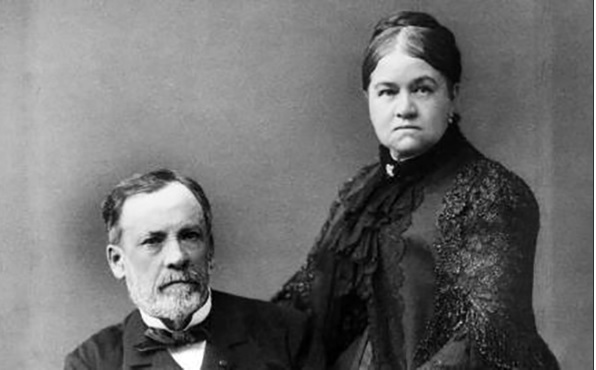
A loving wife was an assistant and a reliable support for her husband. The couple had five children. But, unfortunately, typhoid fever claimed the lives of three. These personal tragedies will force the scientist to seek a cure for contagious infections. And in many years he will discover a life-saving vaccine! The scientist was a sincerely believing Catholic.
Illness and death
In the prime of his life (45 years old), the scientist became disabled. After that, his arm and leg did not move, but the microbiologist continued to work hard. Over the next 27 years, he suffered a series of strokes. The brilliant scientist died of uremia. This happened in September 1895. He was 72 years old.
Additional Information
